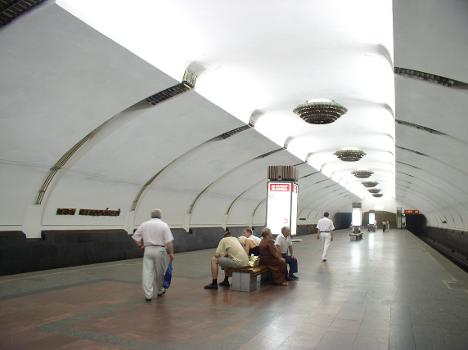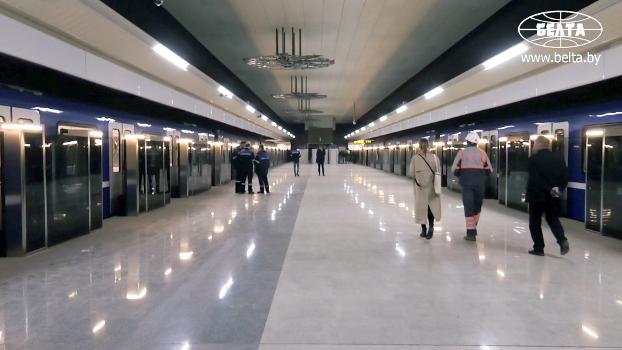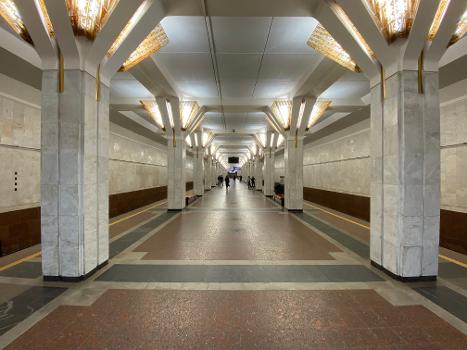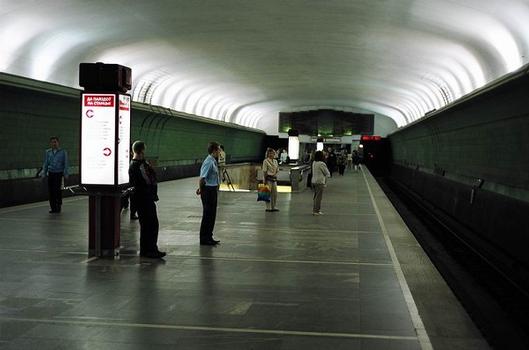General Information
| Name in local language: | Мінскі мэтрапалітэн |
|---|---|
| Completion: | 30 June 1984 |
| Status: | in use |
Project Type
| Function / usage: |
Metro (rapid transit) network |
|---|
Location
| km | Name |
Technical Information
Dimensions
| number of stations | 33 | |
| system length | 40.8 km | |
| maximum speed | 80 km/h | |
| track gauge | 1 520 mm |
Excerpt from Wikipedia
The Minsk Metro (Belarusian: Мінскі метрапалітэн, Russian: Минский метрополитен) is a rapid transit system that serves Minsk, the capital of Belarus. Opened in 1984, it presently consists of 3 lines and 33 stations, totaling 40.8 kilometres (25.4 mi). In 2013, the system carried 328.3 million passengers, which averages to a daily ridership of approximately 899,450.
History
During the 1950s–1970s the population of the city grew to over a million and designs for a rapid transit system were initially proposed during the late 1960s. Construction began on 3 May 1977, and the system was opened to the public on 30 June 1984, becoming the ninth metro system in the Soviet Union. The original eight station section has since expanded into a three-line 33 station network with 40.8 kilometres (25.4 mi) of route.
Despite the dissolution of the Soviet Union the construction of the Minsk metro continued uninterrupted throughout the 1990s (as opposed to other ex-Soviet Metros like those of Yerevan and Samara, which were halted due to a complete lack of funding). Some experts attribute it to the slow reform of the Soviet planned economy in Belarus, which turned out to be beneficial for metro expansion. For example, the final phase of the Aŭtazavodskaja Line, originally planned for 2006, was opened in late 2005, and similarly the northern extension of the Maskoŭskaja Line, originally scheduled for 2008, opened on 7 November 2007. There were also 3 new stations opened on the southern end of the Maskoŭskaja line in November 2012.
Timeline
Segment Line Date opened Instytut Kultury–Maskoŭskaja Maskoŭskaja 30 June 1984 Maskoŭskaja–Uschod Maskoŭskaja 30 December 1986 Traktarny zavod–Frunzienskaja Aŭtazavodskaja 31 December 1990 Pieršamajskaja Aŭtazavodskaja 28 May 1991 Frunzienskaja–Puškinskaja Aŭtazavodskaja 3 July 1995 Traktarny zavod–Aŭtazavodskaja Aŭtazavodskaja 7 November 1997 Aŭtazavodskaja–Mahilioŭskaja Aŭtazavodskaja 5 September 2001 Puškinskaja–Kamiennaja Horka Aŭtazavodskaja 7 November 2005 Uschod–Uručča Maskoŭskaja 7 November 2007 Instytut Kultury–Piatroŭščyna Maskoŭskaja 7 November 2012 Piatroŭščyna–Malinaŭka Maskoŭskaja 3 June 2014 Jubiliejnaja plošča–Kavaĺskaja Slabada Zelenalužskaja 6 November 2020
Operational characteristics
The city is located on an almost level surface and on very dry soils. As a result, although all of the Minsk Metro stations are under the surface, there are no deep-level stations that are found in most of the ex-Soviet cities. Out of the current 33 stations 19 are pillar-spans and 10 are of vaulted type. Like most of the Soviet metro systems, all of the stations are vividly decorated. Some (notably, Niamiha) exhibit Belarusian national motifs, others focus on more Soviet socialist themes. Although recent years saw more priority on high-tech decorations.
Signs in the metro system are in Belarusian and English and announcements are in Russian.
Expansion plans
Platform of a Minsk Metro station Proposed expansion plan Main article: List of Minsk Metro stations This section does not cite any sources. Please help improve this section by adding citations to reliable sources. Unsourced material may be challenged and removed. (April 2011) (Learn how and when to remove this template message)
Construction of a third line, the Zelenoluzhskaya line (shown in green), began in 2014. When completed, this third line will run from the south to the northeast of the city via the centre, creating two new transfer points with the existing lines.
The first stage of the line was opened on 7 November 2020. This follows a northern contour parallel to Maskowskaya, and relieved the extensive congestion in the city area.
As of November 2020, the Zelenoluzhskaya line consisted of four stations. While this Line 3 is planned to be extended north to the residential area of Zeleny Lug, a southern extension to Slutskiy Gostinets is already under construction (est. 2023).
A planned fourth line is expected to connect southeastern parts of the city with the northwestern residential areas, from Vesnyanka in the northwest to Serebryanka in the south, via Akademiya Nauk and Traktornyiy Zavod on the existing lines.
Incidents
1999 stampede
On 30 May 1999, a sudden thunderstorm caused a large crowd, from a nearby rock concert, to seek shelter at the Nyamiha station. The limited size of the underpass leading into the ticket hall and the wet pavement caused a human crush. Fifty-three people died.
2011 bombing
The Kastrychnitskaya station was the site of a terrorist bombing on 11 April 2011. Fifteen people were killed.
Text imported from Wikipedia article "Minsk Metro" and modified on April 4, 2022 according to the CC-BY-SA 4.0 International license.
Participants
Currently there is no information available about persons or companies having participated in this project.
Relevant Web Sites
- About this
data sheet - Structure-ID
10082622 - Published on:
25/03/2022 - Last updated on:
28/03/2022








